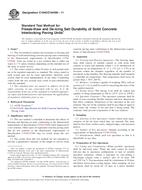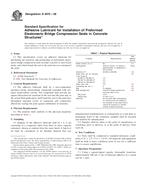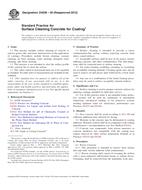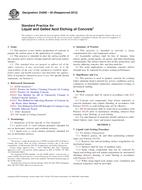Potřebujeme váš souhlas k využití jednotlivých dat, aby se vám mimo jiné mohly ukazovat informace týkající se vašich zájmů. Souhlas udělíte kliknutím na tlačítko „OK“.
ASTM D6760-14
Standard Test Method for Integrity Testing of Concrete Deep Foundations by Ultrasonic Crosshole Testing
Automaticky přeložený název:
Standardní zkušební metoda pro testování integrity betonových hlubinných ultrazvukovými Crosshole testování
NORMA vydána dne 1.6.2014
Informace o normě:
Označení normy: ASTM D6760-14
Poznámka: NEPLATNÁ
Datum vydání normy: 1.6.2014
Kód zboží: NS-36432
Počet stran: 7
Přibližná hmotnost: 21 g (0.05 liber)
Země: Americká technická norma
Kategorie: Technické normy ASTM
Kategorie - podobné normy:
Anotace textu normy ASTM D6760-14 :
Keywords:
barrette, bored pile, crosshole sonic logging, crosshole testing, drilled shaft, integrity test, single hole ultrasonic testing, ultrasonic logging, ultrasonic testing, ICS Number Code 91.080.40 (Concrete structures)
Doplňující informace
| Significance and Use | ||||||||||
|
5.1 This method uses data from ultrasonic probes lowered into parallel access ducts, or in a single access duct, in the deep foundation element to assess the homogeneity and integrity of concrete between the probes. The data are used to confirm adequate concrete quality or identify zones of poor quality. If defects are detected, then further investigations should be made by excavation or coring the concrete as appropriate, or by other testing such as Test Method D1143, D4945 or D5882, and measures taken to remediate the structure if a defect is confirmed. Note 1: The quality of the result produced by this standard is
dependent on the competence of the personnel performing it, and the
suitability of the equipment and facilities used. Agencies that
meet the criteria of Practice D3740 are generally considered capable of
competent and objective testing and inspection. Users of this
standard are cautioned that compliance with Practice D3740 does not in itself assure reliable
results. Reliable results depend on many factors; Practice
D3740 provides a means of
evaluating some of those factors.
|
||||||||||
| 1. Scope | ||||||||||
|
1.1 This test method covers procedures for checking the homogeneity and integrity of concrete in deep foundation such as bored piles, drilled shafts, concrete piles or augercast piles. This method can also be extended to diaphragm walls, barrettes, dams etc. In this test method, all the above will be designated “deep foundation elements.” The test measures the propagation time and relative energy of an ultrasonic pulse between parallel access ducts (crosshole) or in a single tube (single hole) installed in the deep foundation element. This method is most applicable when performed in tubes that are installed during construction. 1.2 Similar techniques with different excitation sources exist, but these techniques are outside the scope of this test method. 1.3 All observed and calculated values shall conform to the guidelines for significant digits and rounding established in Practice D6026. 1.3.1 The method used to specify how data are collected, calculated, or recorded in this standard is not directly related to the accuracy to which data can be applied in design or other uses, or both. How one applies the results obtained using this standard is beyond its scope. 1.4 The method used to specify how data are collected, calculated, or recorded in this test method is not directly related to the accuracy to which data can be applied in design or other uses, or both. How one applies the results obtained using this standard is beyond its scope. 1.5 This standard provides minimum requirements for crosshole (or single hole) testing of concrete deep foundation elements. Plans, specifications, provisions, or combinations thereof prepared by a qualified engineer, and approved by the agency requiring the test(s), may provide additional requirements and procedures as needed to satisfy the objectives of a particular test program. 1.6 The text of this standard references notes and footnotes which provide explanatory material. These notes and footnotes (excluding those in tables and figures) shall not be considered as requirements of the standard. 1.7 The values stated in SI units are to be regarded as standard. No other units of measurement are included in this standard. 1.8 Limitations—Proper installation of the access ducts is essential for effective testing and interpretation. The method does not give the exact type of defect (for example, inclusion, honeycombing, lack of cement particles, etc.) but rather only that a defect exists. The method is limited primarily to testing the concrete between the access ducts and thus gives little information about the concrete outside the reinforcement cage to which the access ducts are attached when the tubes are attached to the inside of the reinforcement cage. 1.9 This standard does not purport to address all of the safety concerns, if any, associated with its use. It is the responsibility of the user of this standard to establish appropriate safety and health practices and determine the applicability of regulatory limitations prior to use. |
||||||||||
| 2. Referenced Documents | ||||||||||
|
Podobné normy:
Historická
1.12.2010
Historická
15.12.2011
Historická
1.7.2008
Historická
1.5.2012
Historická
1.5.2012
Historická
1.5.2012



 ASTM C1603-10
ASTM C1603-10 ASTM C1645/C1645M-11..
ASTM C1645/C1645M-11.. ASTM D4070-08
ASTM D4070-08 ASTM D4258-05(2012)..
ASTM D4258-05(2012).. ASTM D4259-88(2012)..
ASTM D4259-88(2012).. ASTM D4260-05(2012)..
ASTM D4260-05(2012)..
 Cookies
Cookies
